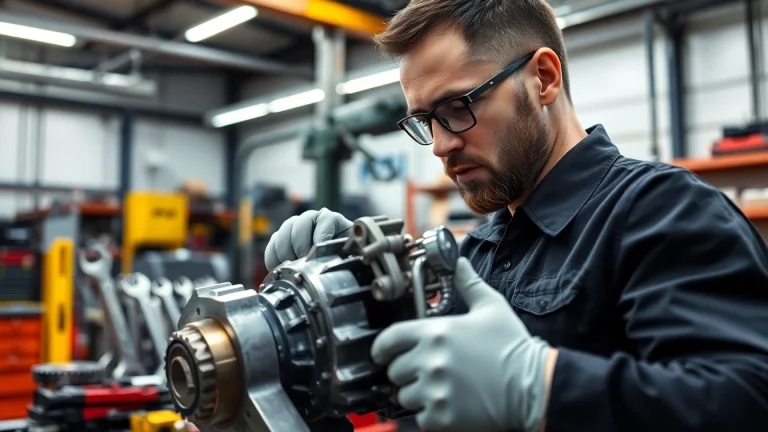
Understanding Gearbox Syncro: Key Functions and Maintenance Tips
1. Introduction to Gearbox Syncros
In the world of automotive mechanics, understanding the intricacies of your vehicle’s gearbox is essential for optimal performance. One crucial component of this system is the gearbox syncro, or synchronizer, which plays a pivotal role in ensuring smooth gear transitions. Gearbox syncros facilitate the engagement of gears with minimal noise or teeth grinding, which is vital for maintaining vehicle longevity and safety. In this article, we will explore the functions of gearbox syncros, their significance in vehicle operation, and the best practices for maintenance and troubleshooting.
1.1 What is a Gearbox Syncro?
A gearbox syncro is a mechanical device within the transmission system of a vehicle that helps in merging two gears together smoothly. It allows for the meshing of rotating gears at different speeds, helping drivers shift gears seamlessly. The syncro works by bringing the speeds of the gears to match before the engagement occurs, thereby reducing wear on the gear teeth and enhancing the overall driving experience. Understanding the mechanical function and design of syncros can lead to better maintenance and fewer issues down the line.
1.2 How Gearbox Syncros Work
The operation of a gearbox syncro revolves around friction and speed matching. When a driver shifts gears, the syncro engages by momentarily converting kinetic energy into friction to equalize the speeds of the gears. This process involves several components:
- Syncro Ring: These rings are made of high-friction material and are pivotal for speed matching.
- Synchronizer Hub: This part connects the syncro ring to the gear, allowing for seamless movement.
- Blocking Ring: Ensures that the gears do not engage until their speeds are synchronized.
This sophisticated mechanism is why modern vehicles can shift gears smoothly, without the jarring movement characteristic of older models without syncros.
1.3 Common Issues with Gearbox Syncros
Despite their intricate design, gearbox syncros can face several common issues which may result in compromised performance. Some of the typical problems include:
- Worn Syncro Rings: Over time, the material in syncro rings can degrade, making them unable to perform their function effectively.
- Oil Contamination: Dirty or contaminated transmission fluid can contribute to syncro wear, leading to shifting problems.
- Alignment Issues: Misalignment due to wear or improper installation can cause difficulties in engaging gears.
Recognizing these issues early can help prevent further damage to the transmission system.
2. Importance of Gearbox Syncro Maintenance
Maintaining your gearbox syncros is not just a matter of performance, but it directly affects the health of the entire vehicle transmission system. Regularly attending to syncro health can prolong the life of your transmission and improve your driving experience.
2.1 Signs Your Gearbox Syncro Needs Attention
Being vigilant about the performance of your gearbox syncros can save you from costly repairs. Here are signs indicating that maintenance is needed:
- Grinding Noises: If you hear grinding when shifting gears, this may signal that the syncro is failing.
- Difficulty Engaging Gears: If you find it challenging to shift into certain gears, especially after a hard stop, this might indicate worn syncros.
- Unusual Vibrations: Vibration during gear changes can point towards a misalignment within the transmission system.
Addressing these symptoms promptly can lead to more manageable fixes.
2.2 Regular Maintenance Routines
Establishing regular maintenance routines for your gearbox syncros is crucial for their longevity. Here are key strategies you can implement:
- Fluid Changes: Regularly changing the transmission fluid helps prevent wear on your syncros by ensuring they operate under the best conditions.
- Visual Inspections: Regularly inspecting the gearbox for leaks, corrosion, or unusual wear can catch potential syncro issues early.
- Professional Diagnostics: Having a trusted mechanic perform diagnostics can provide insights that may not be visible during routine checks.
Consistent attention to these areas can maintain the health of your gearbox syncros.
2.3 Cost-Effective Maintenance Tips
While maintenance may seem like a daunting expense, there are cost-effective strategies to keep your gearbox syncros in good shape:
- DIY Fluid Replacement: Learning to change the transmission fluid yourself can save on labor costs.
- Regular Cleaning: Keeping the external parts of the transmission clean can prolong the life of syncros.
- Use Quality Products: Investing in high-quality transmission fluid can enhance syncro functionality and lead to better overall performance.
By adopting these practices, car owners can protect their investments without breaking the bank.
3. Troubleshooting Gearbox Syncro Problems
If you experience gearbox syncro issues, knowing how to troubleshoot can save time and money. This section provides insights into common faults and their resolutions.
3.1 Diagnosing Common Syncro Faults
Diagnosing gearbox syncro problems involves looking for specific signs and understanding what they mean. Here’s how to address common syncro faults:
- Grinding Gears: If gears grind during shifting, check the health of the syncro rings and consider a fluid change.
- Pop-Out Gears: If a gear pops out, this could mean the syncro and blocker ring are worn out, needing replacement.
- Stuck Gears: Inability to shift into one or more gears may indicate a serious syncro failure or internal damage to the gearbox.
Through methodical testing and visual inspections, you can identify and rectify these issues.
3.2 Tools for Syncro Repair
Having the proper tools can significantly simplify the repair and maintenance process for gearbox syncros. Some essential tools include:
- Socket Set: A comprehensive socket set is critical for disassembling parts of the gearbox.
- Torque Wrench: Proper torque specifications during reassembly are crucial to maintaining integrity.
- Transmission Jack: A dedicated jack makes it easier and safer to lift the vehicle for access to the gearbox.
Equipping yourself with these tools will aid in successful diagnostics and repairs.
3.3 When to Seek Professional Help
Not every gearbox syncro issue is suitable for DIY fixes. Knowing when to consult a professional can save further complications:
- Complex Diagnosis: If the issue appears complicated and beyond basic maintenance, seek help from a qualified mechanic.
- Full Transmission Overhaul: Major issues could require a complete overhaul of the transmission, best left to experts.
- Safety Concerns: If you suspect critical failures that could compromise vehicle safety, do not hesitate to consult a specialist.
Professional mechanics possess the training and tools necessary for comprehensive evaluations and repairs.
4. Upgrading Gearbox Syncros
For performance-driven enthusiasts, upgrading gearbox syncros can yield significant improvements in driving experience. In this section, we will explore the benefits, selection of parts, and installation tips.
4.1 Benefits of Upgrading Your Gearbox Syncro
Upgrading your gearbox syncros can enhance your driving experience in several ways:
- Improved Shifting Performance: Upgraded syncros allow for quicker and more precise gear changes, especially in high-performance settings.
- Increased Durability: Premium syncro materials can withstand greater wear, providing longevity and reliability in driving.
- Better Response Under Load: Enhanced syncros can maintain shifting efficiency even under demanding driving conditions.
For motorsport enthusiasts or those who frequently drive in challenging conditions, these upgrades can transform performance.
4.2 Choosing the Right Replacement Parts
Selecting the right parts for gear syncros is critical for optimal performance. Consider these factors:
- Material Quality: Opt for components made of high-friction, durable materials that can handle stress.
- Compatibility: Ensure the replacement syncros are compatible with your vehicle’s make and model.
- Review and Ratings: Look for products with positive reviews and proven reliability.
Research and diligence in choosing parts can lead to successful upgrades.
4.3 Installation Tips for DIY Enthusiasts
If you are considering installing syncro upgrades on your own, follow these installation tips:
- Read Manufacturer Guidelines: Detailed instructions can help ensure correct installation.
- Take Notes: Document the disassembly process to make reassembly easier.
- Use New Transmission Fluid: When completing the installation, always use fresh, quality fluid for best performance.
By following these tips, you can increase the odds of a successful installation.
5. Conclusion and Future Trends in Gearbox Syncros
As automotive technology continues to roll out innovations, gearbox syncros remain a vital component of vehicle performance. Understanding their functions, maintaining them, and knowing when to upgrade or repair can lead to substantial benefits.
5.1 Summary of Key Points
In this article, we have explored the following key points regarding gearbox syncros:
- The definition and function of gearbox syncros.
- The importance of regular maintenance and signs to look for.
- How to troubleshoot common syncro issues.
- Benefits of upgrading and guidelines for selecting parts.
A proactive approach to syncro care can prevent damage and extend the lifespan of your vehicle’s transmission.
5.2 Innovations in Gearbox Technology
The future of gearbox syncros is increasingly tied to technological advancements. Innovations in designs, such as electronically controlled syncros, are emerging, promising even smoother shifts and improved efficiency. Additionally, the development of advanced materials is expected to enhance durability and performance even further, leading to exciting possibilities in vehicle engineering.
5.3 The Future of Gearbox Syncro Designs
As vehicles evolve towards electric and hybrid technologies, the designs of syncros will likely adapt to meet new demands. Future trends may include integration with smart technologies, allowing for real-time adjustments to enhance performance and efficiency across various driving conditions. It’s an exciting time for gearbox innovations, and staying informed will be essential for both manufacturers and enthusiasts alike.


